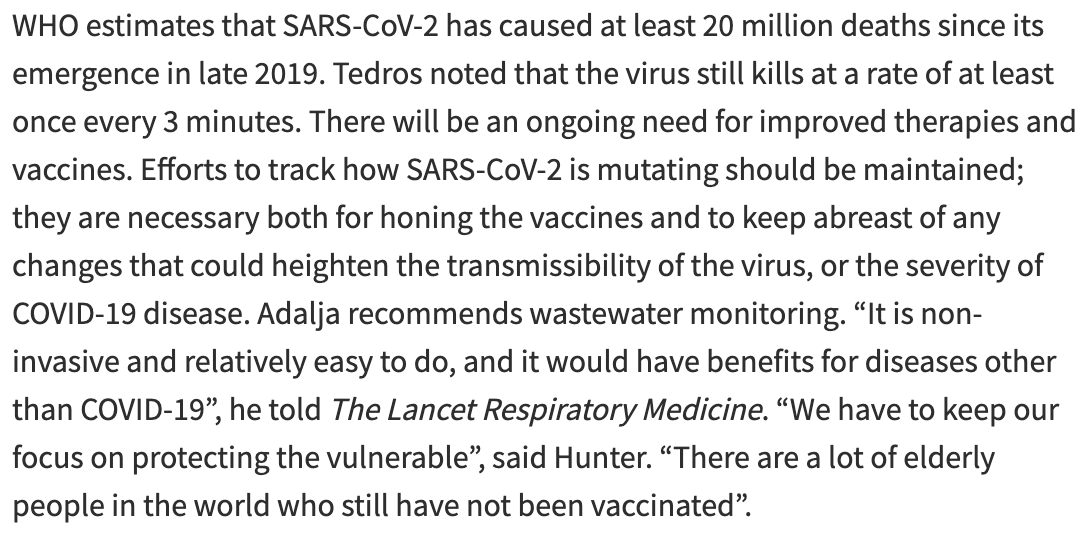
WHO ends the COVID-19 public health emergency
, T., The Lancet Respiratory Medicine, doi:10.1016/S2213-2600(23)00217-5, Jul 2023
News report on WHO's announcement ending the COVID-19 public health emergency, noting that WHO estimates SARS-CoV-2 has caused at least 20 million deaths.
Burki et al., 31 Jul 2023, peer-reviewed, 1 author.
Abstract: News
Sam Falconer, Debut Art/Science Photo Library
WHO ends the COVID-19 public health emergency
Published Online
May 26, 2023
https://doi.org/10.1016/
S2213-2600(23)00217-5
For Tedros’ statement see
https://www.who.int/directorgeneral/speeches/detail/whodirector-general-s-openingremarks-at-the-media-briefing--5-may-2023
For more on vaccine estimates
see Articles Lancet Infect Dis
2022; 22: 1293–302
For the Strategic Preparedness
and Response Plan see https://
www.who.int/publications/i/
item/WHO-WHE-SPP-2023.1
588
On May 5, 2023, WHO DirectorGeneral Tedros Adhanom Ghebreyesus
announced that COVID-19 no longer
constituted a public health emergency
of international concern (PHEIC).
“For more than a year, the pandemic
has been on a downward trend, with
population immunity increasing from
vaccination and infection, mortality
decreasing and the pressure on health
systems easing”, explained Tedros, in
remarks to the media. He added that
most countries have returned to a life
similar to that before the pandemic
and the WHO Emergency Committee,
on whose advice the PHEIC was
declared in January, 2020, was now
recommending that the PHEIC be
lifted. “It is therefore with great
hope that I declare COVID-19 over as
a global health emergency”, Tedros
concluded.
A key criteria for a PHEIC is
that an outbreak should be an
extraordinary event. The WHO
Emergency Committee decided
that this criteria was no longer met
for COVID-19. “It was the right
decision”, commented Amesh Adalja,
Senior Scholar at the Johns Hopkins
Bloomberg School of Public
Health (Baltimore, MD, USA). “In
January 2020, this was a novel virus
that was threatening the functioning
of health-care systems worldwide.
We did not have any medical
countermeasures and we did not
know very much about what we were
dealing with. We are in a very different
situation today”.
Paul Hunter is a Professor in
Medicine at the University of
East Anglia (Norwich, UK). “The whole
issue in the control of COVID-19 has
been one of balancing harms against
benefits”, he said. “With the exception
of vaccination, the interventions
that have been used to suppress
SARS-CoV-2 on a societal level now
mainly do more harm than good.
There is no need for the PHEIC”.
Two-thirds of the world’s
population, including 89% of health
workers and 82% of adults older
than 60 years, have received at least
two doses of the COVID-19 vaccines.
A modelling study published
in The Lancet Infectious Diseases
estimated that the vaccines saved
14·4–19·8 million lives in the first
year of rollout. In the week ending
May 8, 2023, WHO was notified of
546 435 infections with SARS-CoV-2
and 4266 deaths. Both figures
were lower than for any week since
March, 2020, although admittedly
there is currently far less testing and
reporting. “We know that the severity
of SARS-CoV-2 decreases the more
times you are infected, so for most
people this will be an increasingly
mild disease”, said Hunter.
Discontinuation of the PHEIC is
largely of symbolic value. PHEICs
capture attention and allow easier
raising of funds, but they are not
associated with any meaningful
power. For US citizens, the
expiration of the federal Public
Health Emergency for COVID-19
on May 11 was more substantial
because it implied looser surveillance
and an end to free testing. In his
remarks to the media, Tedros urged
nations to stay vigilant. “The worst
thing any country could do now is
to use this news as a reason to let
down its guard, to dismantle the
systems it has..
DOI record:
{
"DOI": "10.1016/s2213-2600(23)00217-5",
"ISSN": [
"2213-2600"
],
"URL": "http://dx.doi.org/10.1016/S2213-2600(23)00217-5",
"alternative-id": [
"S2213260023002175"
],
"assertion": [
{
"label": "This article is maintained by",
"name": "publisher",
"value": "Elsevier"
},
{
"label": "Article Title",
"name": "articletitle",
"value": "WHO ends the COVID-19 public health emergency"
},
{
"label": "Journal Title",
"name": "journaltitle",
"value": "The Lancet Respiratory Medicine"
},
{
"label": "CrossRef DOI link to publisher maintained version",
"name": "articlelink",
"value": "https://doi.org/10.1016/S2213-2600(23)00217-5"
},
{
"label": "CrossRef DOI link to the associated document",
"name": "associatedlink",
"value": "https://doi.org/10.1016/S1473-3099(22)00320-6"
},
{
"label": "Content Type",
"name": "content_type",
"value": "simple-article"
},
{
"label": "Copyright",
"name": "copyright",
"value": "© 2023 Elsevier Ltd. All rights reserved."
}
],
"author": [
{
"affiliation": [],
"family": "Burki",
"given": "Talha",
"sequence": "first"
}
],
"container-title": "The Lancet Respiratory Medicine",
"container-title-short": "The Lancet Respiratory Medicine",
"content-domain": {
"crossmark-restriction": true,
"domain": [
"clinicalkey.fr",
"clinicalkey.jp",
"clinicalkey.com.au",
"clinicalkey.es",
"clinicalkey.com",
"thelancet.com",
"elsevier.com",
"sciencedirect.com"
]
},
"created": {
"date-parts": [
[
2023,
5,
26
]
],
"date-time": "2023-05-26T22:35:20Z",
"timestamp": 1685140520000
},
"deposited": {
"date-parts": [
[
2023,
7,
5
]
],
"date-time": "2023-07-05T02:17:01Z",
"timestamp": 1688523421000
},
"indexed": {
"date-parts": [
[
2025,
8,
12
]
],
"date-time": "2025-08-12T21:45:40Z",
"timestamp": 1755035140284
},
"is-referenced-by-count": 70,
"issue": "7",
"issued": {
"date-parts": [
[
2023,
7
]
]
},
"journal-issue": {
"issue": "7",
"published-print": {
"date-parts": [
[
2023,
7
]
]
}
},
"language": "en",
"license": [
{
"URL": "https://www.elsevier.com/tdm/userlicense/1.0/",
"content-version": "tdm",
"delay-in-days": 0,
"start": {
"date-parts": [
[
2023,
7,
1
]
],
"date-time": "2023-07-01T00:00:00Z",
"timestamp": 1688169600000
}
}
],
"link": [
{
"URL": "https://api.elsevier.com/content/article/PII:S2213260023002175?httpAccept=text/xml",
"content-type": "text/xml",
"content-version": "vor",
"intended-application": "text-mining"
},
{
"URL": "https://api.elsevier.com/content/article/PII:S2213260023002175?httpAccept=text/plain",
"content-type": "text/plain",
"content-version": "vor",
"intended-application": "text-mining"
}
],
"member": "78",
"original-title": [],
"page": "588",
"prefix": "10.1016",
"published": {
"date-parts": [
[
2023,
7
]
]
},
"published-print": {
"date-parts": [
[
2023,
7
]
]
},
"publisher": "Elsevier BV",
"reference-count": 0,
"references-count": 0,
"relation": {},
"resource": {
"primary": {
"URL": "https://linkinghub.elsevier.com/retrieve/pii/S2213260023002175"
}
},
"score": 1,
"short-title": [],
"source": "Crossref",
"subject": [],
"subtitle": [],
"title": "WHO ends the COVID-19 public health emergency",
"type": "journal-article",
"update-policy": "http://dx.doi.org/10.1016/elsevier_cm_policy",
"volume": "11"
}